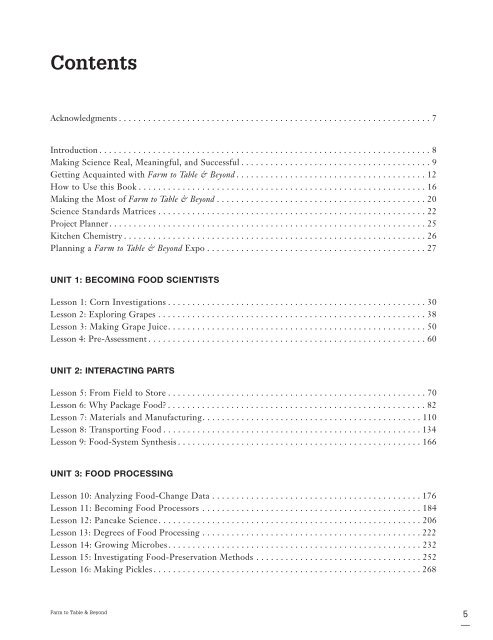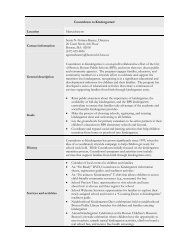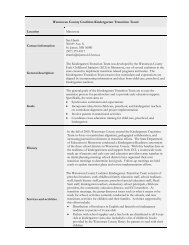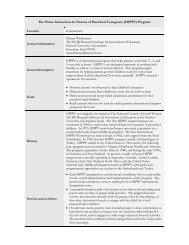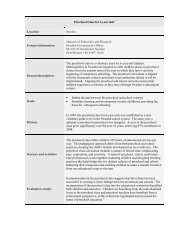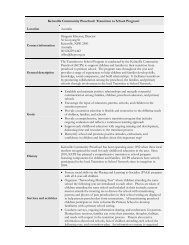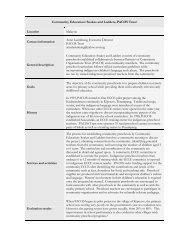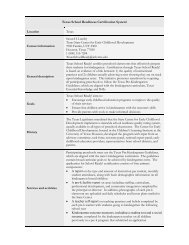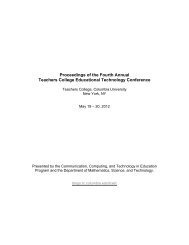the table of contents from Farm to Table & Beyond (PDF)
the table of contents from Farm to Table & Beyond (PDF)
the table of contents from Farm to Table & Beyond (PDF)
Create successful ePaper yourself
Turn your PDF publications into a flip-book with our unique Google optimized e-Paper software.
Contents<br />
Acknowledgments . . . . . . . . . . . . . . . . . . . . . . . . . . . . . . . . . . . . . . . . . . . . . . . . . . . . . . . . . . . . . . . . 7<br />
Introduction . . . . . . . . . . . . . . . . . . . . . . . . . . . . . . . . . . . . . . . . . . . . . . . . . . . . . . . . . . . . . . . . . . . . 8<br />
Making Science Real, Meaningful, and Successful . . . . . . . . . . . . . . . . . . . . . . . . . . . . . . . . . . . . . . . 9<br />
Getting Acquainted with <strong>Farm</strong> <strong>to</strong> <strong>Table</strong> & <strong>Beyond</strong> . . . . . . . . . . . . . . . . . . . . . . . . . . . . . . . . . . . . . . . 12<br />
How <strong>to</strong> Use this Book . . . . . . . . . . . . . . . . . . . . . . . . . . . . . . . . . . . . . . . . . . . . . . . . . . . . . . . . . . . 16<br />
Making <strong>the</strong> Most <strong>of</strong> <strong>Farm</strong> <strong>to</strong> <strong>Table</strong> & <strong>Beyond</strong> . . . . . . . . . . . . . . . . . . . . . . . . . . . . . . . . . . . . . . . . . . . 20<br />
Science Standards Matrices . . . . . . . . . . . . . . . . . . . . . . . . . . . . . . . . . . . . . . . . . . . . . . . . . . . . . . . 22<br />
Project Planner. . . . . . . . . . . . . . . . . . . . . . . . . . . . . . . . . . . . . . . . . . . . . . . . . . . . . . . . . . . . . . . . . 25<br />
Kitchen Chemistry . . . . . . . . . . . . . . . . . . . . . . . . . . . . . . . . . . . . . . . . . . . . . . . . . . . . . . . . . . . . . . 26<br />
Planning a <strong>Farm</strong> <strong>to</strong> <strong>Table</strong> & <strong>Beyond</strong> Expo . . . . . . . . . . . . . . . . . . . . . . . . . . . . . . . . . . . . . . . . . . . . . 27<br />
UNIT 1: BECOMING FOOD SCIENTISTS<br />
Lesson 1: Corn Investigations . . . . . . . . . . . . . . . . . . . . . . . . . . . . . . . . . . . . . . . . . . . . . . . . . . . . . 30<br />
Lesson 2: Exploring Grapes . . . . . . . . . . . . . . . . . . . . . . . . . . . . . . . . . . . . . . . . . . . . . . . . . . . . . . . 38<br />
Lesson 3: Making Grape Juice. . . . . . . . . . . . . . . . . . . . . . . . . . . . . . . . . . . . . . . . . . . . . . . . . . . . . 50<br />
Lesson 4: Pre-Assessment . . . . . . . . . . . . . . . . . . . . . . . . . . . . . . . . . . . . . . . . . . . . . . . . . . . . . . . . . 60<br />
UNIT 2: INTERACTING PARTS<br />
Lesson 5: From Field <strong>to</strong> S<strong>to</strong>re . . . . . . . . . . . . . . . . . . . . . . . . . . . . . . . . . . . . . . . . . . . . . . . . . . . . . 70<br />
Lesson 6: Why Package Food? . . . . . . . . . . . . . . . . . . . . . . . . . . . . . . . . . . . . . . . . . . . . . . . . . . . . . 82<br />
Lesson 7: Materials and Manufacturing. . . . . . . . . . . . . . . . . . . . . . . . . . . . . . . . . . . . . . . . . . . . . 110<br />
Lesson 8: Transporting Food . . . . . . . . . . . . . . . . . . . . . . . . . . . . . . . . . . . . . . . . . . . . . . . . . . . . . 134<br />
Lesson 9: Food-System Syn<strong>the</strong>sis . . . . . . . . . . . . . . . . . . . . . . . . . . . . . . . . . . . . . . . . . . . . . . . . . . 166<br />
UNIT 3: FOOD PROCESSING<br />
Lesson 10: Analyzing Food-Change Data . . . . . . . . . . . . . . . . . . . . . . . . . . . . . . . . . . . . . . . . . . . 176<br />
Lesson 11: Becoming Food Processors . . . . . . . . . . . . . . . . . . . . . . . . . . . . . . . . . . . . . . . . . . . . . 184<br />
Lesson 12: Pancake Science. . . . . . . . . . . . . . . . . . . . . . . . . . . . . . . . . . . . . . . . . . . . . . . . . . . . . . 206<br />
Lesson 13: Degrees <strong>of</strong> Food Processing . . . . . . . . . . . . . . . . . . . . . . . . . . . . . . . . . . . . . . . . . . . . . 222<br />
Lesson 14: Growing Microbes. . . . . . . . . . . . . . . . . . . . . . . . . . . . . . . . . . . . . . . . . . . . . . . . . . . . 232<br />
Lesson 15: Investigating Food-Preservation Methods . . . . . . . . . . . . . . . . . . . . . . . . . . . . . . . . . . 252<br />
Lesson 16: Making Pickles . . . . . . . . . . . . . . . . . . . . . . . . . . . . . . . . . . . . . . . . . . . . . . . . . . . . . . . 268<br />
<strong>Farm</strong> <strong>to</strong> <strong>Table</strong> & <strong>Beyond</strong><br />
5<br />
—
UNIT 4: ENVIRONMENTAL EFFECTS<br />
Lesson 17: Planet Earth . . . . . . . . . . . . . . . . . . . . . . . . . . . . . . . . . . . . . . . . . . . . . . . . . . . . . . . . . 282<br />
Lesson 18: Natural Resources . . . . . . . . . . . . . . . . . . . . . . . . . . . . . . . . . . . . . . . . . . . . . . . . . . . . 296<br />
Lesson 19: The Carbon Cycle . . . . . . . . . . . . . . . . . . . . . . . . . . . . . . . . . . . . . . . . . . . . . . . . . . . . 310<br />
Lesson 20: Earth’s Changing Climate. . . . . . . . . . . . . . . . . . . . . . . . . . . . . . . . . . . . . . . . . . . . . . . 322<br />
Lesson 21: Transportation Effects . . . . . . . . . . . . . . . . . . . . . . . . . . . . . . . . . . . . . . . . . . . . . . . . . 332<br />
Lesson 22: Packaging Effects . . . . . . . . . . . . . . . . . . . . . . . . . . . . . . . . . . . . . . . . . . . . . . . . . . . . . 342<br />
Lesson 23: Processing Effects . . . . . . . . . . . . . . . . . . . . . . . . . . . . . . . . . . . . . . . . . . . . . . . . . . . . 352<br />
Lesson 24: Effects, Effects, Effects . . . . . . . . . . . . . . . . . . . . . . . . . . . . . . . . . . . . . . . . . . . . . . . . 358<br />
UNIT 5: WASTE<br />
Lesson 25: <strong>Beyond</strong> <strong>the</strong> Trash Can . . . . . . . . . . . . . . . . . . . . . . . . . . . . . . . . . . . . . . . . . . . . . . . . . 372<br />
Lesson 26: Waste Inven<strong>to</strong>ry . . . . . . . . . . . . . . . . . . . . . . . . . . . . . . . . . . . . . . . . . . . . . . . . . . . . . . 386<br />
Lesson 27: Analyzing Cafeteria Waste . . . . . . . . . . . . . . . . . . . . . . . . . . . . . . . . . . . . . . . . . . . . . . 406<br />
Lesson 28: Taking Action. . . . . . . . . . . . . . . . . . . . . . . . . . . . . . . . . . . . . . . . . . . . . . . . . . . . . . . . 410<br />
UNIT 6: MAKING CHOICES<br />
Lesson 29: <strong>Farm</strong> <strong>to</strong> <strong>Table</strong> & <strong>Beyond</strong> Expo . . . . . . . . . . . . . . . . . . . . . . . . . . . . . . . . . . . . . . . . . . . . 416<br />
Lesson 30: Bringing It All Toge<strong>the</strong>r . . . . . . . . . . . . . . . . . . . . . . . . . . . . . . . . . . . . . . . . . . . . . . . . 422<br />
Bibliography. . . . . . . . . . . . . . . . . . . . . . . . . . . . . . . . . . . . . . . . . . . . . . . . . . . . . . . . . . . . . . . . . . 426<br />
Sources. . . . . . . . . . . . . . . . . . . . . . . . . . . . . . . . . . . . . . . . . . . . . . . . . . . . . . . . . . . . . . . . . . . . . . 427<br />
Glossary . . . . . . . . . . . . . . . . . . . . . . . . . . . . . . . . . . . . . . . . . . . . . . . . . . . . . . . . . . . . . . . . . . . . . 429<br />
6<br />
—<br />
<strong>Farm</strong> <strong>to</strong> <strong>Table</strong> & <strong>Beyond</strong>
Getting Acquainted with <strong>Farm</strong><br />
<strong>to</strong> <strong>Table</strong> & <strong>Beyond</strong><br />
Throughout this module, you and your students will<br />
investigate <strong>the</strong> question What is <strong>the</strong> system that gets<br />
food <strong>from</strong> farm <strong>to</strong> <strong>table</strong>, and how does this system affect <strong>the</strong><br />
environment? This question is more complicated than it<br />
may seem. You and your students will learn more about<br />
<strong>the</strong> complex nature <strong>of</strong> our food system in this module,<br />
and begin <strong>to</strong> explore <strong>the</strong> impact <strong>of</strong> human activity on<br />
<strong>the</strong> natural world.<br />
As you begin your investigations, you’ll find yourself<br />
immersed in a world <strong>of</strong> interconnected systems. You will<br />
be exploring <strong>the</strong> subsystems <strong>of</strong> our immense, technological<br />
farm-<strong>to</strong>-<strong>table</strong> system — packaging, processing,<br />
transportation, and <strong>the</strong> byproducts, including waste,<br />
that are produced by this system. This module is an<br />
interweaving <strong>of</strong> learning about science, technology, and<br />
society. You and your students will come <strong>to</strong> understand<br />
that technology is not innately good or bad. Typically,<br />
<strong>the</strong> effects produced by technology are hard <strong>to</strong> estimate<br />
accurately and likely <strong>to</strong> have different values for different<br />
people at different times. In this module you and your<br />
students will create a time line <strong>of</strong> <strong>the</strong> food system with<br />
miles<strong>to</strong>nes in packaging, transportation, food processing,<br />
energy, and garbage. Additionally, student readings will<br />
enhance your studies with a deeper sense <strong>of</strong> <strong>the</strong> his<strong>to</strong>ry<br />
<strong>of</strong> <strong>the</strong> food system. Overall, we hope students come<br />
away with a fuller appreciation <strong>of</strong> <strong>the</strong> enormous effects<br />
that our ability as humans <strong>to</strong> invent <strong>to</strong>ols and processes<br />
have on <strong>the</strong> lives <strong>of</strong> o<strong>the</strong>r living things, on natural systems,<br />
and on <strong>the</strong> state <strong>of</strong> our collective environment.<br />
As part <strong>of</strong> a complex biological system, humans have<br />
responsibilities <strong>to</strong> <strong>the</strong> o<strong>the</strong>r parts <strong>of</strong> our system. To<br />
insure our own survival, we must respect <strong>the</strong> wide<br />
diversity <strong>of</strong> living creatures — both large and small —<br />
and <strong>the</strong> physical components that all life depends on<br />
for growth and sustainability. Our planet has limited<br />
resources that cannot be carelessly wasted or polluted<br />
without running <strong>the</strong> risk <strong>of</strong> jeopardizing life on Earth.<br />
By investigating this module’s question, your students<br />
will become informed citizens, prepared <strong>to</strong> make choices<br />
that will help support a sustainable future for generations<br />
<strong>to</strong> come.<br />
If you have access <strong>to</strong> a school garden, we encourage you<br />
<strong>to</strong> engage your students in growing <strong>the</strong>ir own food.<br />
Such gardens can also serve as living labora<strong>to</strong>ries where<br />
students can set up investigations and moni<strong>to</strong>r <strong>the</strong>m<br />
over time. Gardens are a great place <strong>to</strong> moni<strong>to</strong>r <strong>the</strong><br />
effects <strong>of</strong> changing wea<strong>the</strong>r conditions on ecosystems,<br />
decomposition, <strong>the</strong> seed-<strong>to</strong>-<strong>table</strong> life cycle <strong>of</strong> garden<br />
plants, and much more. The National Gardening<br />
Association’s Web site (www.kidsgardening.org) is<br />
an excellent resource for both ideas and materials.<br />
Overview<br />
This module consists <strong>of</strong> six units, each with its own<br />
driving question.<br />
Unit 1<br />
Becoming Food Scientists introduces LiFE and explores<br />
<strong>the</strong> question What is a food scientist? Investigating corn<br />
motivates students <strong>to</strong> study food. Studying grapes introduces<br />
students <strong>to</strong> LiFE’s QuESTA Learning Cycle.<br />
Assessing what students already know about our farm<strong>to</strong>-<strong>table</strong><br />
food system and how this system affects <strong>the</strong><br />
environment <strong>of</strong>fers a baseline <strong>to</strong> track student growth<br />
throughout this module.<br />
Unit 2<br />
Interacting Parts introduces students <strong>to</strong> thinking about<br />
<strong>the</strong> farm-<strong>to</strong>-<strong>table</strong> system in terms <strong>of</strong> its parts and how <strong>the</strong><br />
various parts relate <strong>to</strong> and interact with each o<strong>the</strong>r <strong>to</strong><br />
create a “whole” through <strong>the</strong> question What is <strong>the</strong> system<br />
that gets food <strong>from</strong> farm <strong>to</strong> <strong>table</strong>? Students investigate<br />
processing, packaging, and transportation as subsystems<br />
within our larger food system. They explore different<br />
kinds <strong>of</strong> packaging and investigate modes <strong>of</strong> transportation.<br />
They begin long-term observations <strong>of</strong> what happens<br />
<strong>to</strong> fresh foods that are left out in <strong>the</strong>ir classroom, <strong>to</strong> gain<br />
an understanding <strong>of</strong> why we preserve food. Students tie<br />
<strong>to</strong>ge<strong>the</strong>r what <strong>the</strong>y have learned by mapping out <strong>the</strong><br />
relationships and interactions <strong>of</strong> <strong>the</strong> parts <strong>to</strong> build<br />
a new conceptual understanding <strong>of</strong> <strong>the</strong> whole.<br />
Unit 3<br />
Food Processing asks students <strong>to</strong> dive deeper in<strong>to</strong> exploring<br />
<strong>the</strong> changes food undergoes in our food system with<br />
12<br />
—<br />
<strong>Farm</strong> <strong>to</strong> <strong>Table</strong> & <strong>Beyond</strong>
<strong>the</strong> question What happens <strong>to</strong> food as it moves <strong>from</strong> farm <strong>to</strong><br />
<strong>table</strong>? Students continue <strong>the</strong>ir long-term observations <strong>of</strong><br />
fresh foods left out in <strong>the</strong> classroom and develop <strong>the</strong>ories<br />
<strong>to</strong> explain <strong>the</strong> changes <strong>the</strong>y observe. They learn about<br />
several methods <strong>of</strong> preserving food through understanding<br />
what microorganisms need <strong>to</strong> grow and methods <strong>to</strong><br />
prevent <strong>the</strong>ir growth. Students experience being food<br />
processors by creating cornmeal, whole-wheat flour, and<br />
butter, <strong>the</strong>n using <strong>the</strong>se ingredients <strong>to</strong> make pancakes<br />
<strong>from</strong> scratch. Through continuing with pancakes and <strong>the</strong><br />
various ways <strong>the</strong>y are available in our marketplace, <strong>the</strong>y<br />
examine differing degrees <strong>of</strong> processing that food can<br />
undergo. They culminate <strong>the</strong>ir studies by becoming food<br />
preservers, making pickles. The unit ends with <strong>the</strong> students<br />
syn<strong>the</strong>sizing what <strong>the</strong>y have learned about <strong>the</strong> science and<br />
technology <strong>of</strong> food processing.<br />
Unit 4<br />
Environmental Effects leads students through a critical<br />
examination <strong>of</strong> <strong>the</strong> effects <strong>of</strong> our dependence on such a<br />
highly technological food system through an exploration<br />
<strong>of</strong> <strong>the</strong> question What are <strong>the</strong> environmental effects <strong>of</strong> our<br />
farm-<strong>to</strong>-<strong>table</strong> system? Students investigate what is needed<br />
<strong>to</strong> sustain <strong>the</strong> natural environment and how we, as<br />
humans, use natural resources <strong>to</strong> create “goods” that<br />
will meet our needs. The students revisit transporting,<br />
packaging, and processing food <strong>to</strong> layer on<strong>to</strong> what <strong>the</strong>y<br />
learned an understanding <strong>of</strong> <strong>the</strong> trade-<strong>of</strong>fs and impacts<br />
<strong>of</strong> our farm-<strong>to</strong>-<strong>table</strong> system. Following this, <strong>the</strong>y examine<br />
<strong>the</strong> importance <strong>of</strong> fossil fuels in our society and how<br />
our dependence on fossil fuels affects <strong>the</strong> environment,<br />
specifically exploring <strong>the</strong>se fuels’ role in increasing<br />
greenhouse-gas emissions and global warming. Students<br />
examine how by-products <strong>of</strong> our food system can<br />
contaminate <strong>the</strong> air, water, and soil that we depend<br />
on <strong>to</strong> produce food.<br />
Unit 5<br />
Waste allows students <strong>to</strong> conduct research that is a<br />
practical application <strong>of</strong> what <strong>the</strong>y have learned by doing<br />
waste-analysis investigations. Through this <strong>the</strong>y explore<br />
<strong>the</strong> question How can we reduce <strong>the</strong> food-related waste that<br />
we produce? Students conduct studies <strong>of</strong> how much food<br />
and food-packaging waste are produced by <strong>the</strong>mselves,<br />
<strong>the</strong>ir families, and <strong>the</strong>ir communities. They learn about<br />
reducing, recycling, reusing, and composting as ways <strong>to</strong><br />
decrease waste production. They develop and carry out<br />
a research plan <strong>to</strong> investigate how much food-related<br />
waste is generated by <strong>the</strong> school cafeteria. Finally, <strong>the</strong>y<br />
analyze <strong>the</strong>ir personal food habits.<br />
Unit 6<br />
Making Choices brings <strong>the</strong> module <strong>to</strong> a close and<br />
encourages students <strong>to</strong> make informed decisions and<br />
changes in <strong>the</strong>ir lives by asking, How can we use <strong>the</strong> science<br />
we learned <strong>to</strong> make ecologically sound food-system choices? In<br />
this unit, students put on a <strong>Farm</strong> <strong>to</strong> <strong>Table</strong> & <strong>Beyond</strong> expo<br />
<strong>to</strong> share what <strong>the</strong>y have learned about <strong>the</strong> global food<br />
system. As a post-assessment, students revisit <strong>the</strong> foodsystem<br />
posters <strong>the</strong>y made in Lesson 4. Finally, <strong>the</strong>y<br />
develop <strong>the</strong>ir own food-choice guidelines based on what<br />
<strong>the</strong>y’ve learned throughout <strong>the</strong> module.<br />
Promoting Inquiry<br />
Teaching science as inquiry makes science a process <strong>of</strong><br />
doing and thinking instead <strong>of</strong> learning a set <strong>of</strong> predetermined<br />
facts. This changes your role as teacher. Instead<br />
<strong>of</strong> being a source <strong>of</strong> science facts, you are a partner with<br />
your students as you seek answers or explanations. It<br />
means turning students’ questions back on <strong>the</strong>m. If a<br />
student asks, “Why does food rot?” respond with, “Well,<br />
I’m not sure. How shall we find out?” This sends a<br />
powerful message — that knowing how <strong>to</strong> find an<br />
answer is as important as knowing <strong>the</strong> answer.<br />
Ask open-ended questions that promote reflection and<br />
fur<strong>the</strong>r questions. “How” and “why” questions work<br />
well: “Why do you think that is?” or “How would we find<br />
out?” Ask questions that encourage critical thinking,<br />
like: “What evidence or observation leads you <strong>to</strong> that<br />
conclusion?” Help your students develop <strong>the</strong>ories and<br />
bring closure <strong>to</strong> <strong>the</strong>ir explorations and experiments by<br />
asking: “How would you explain your results?” and “What<br />
<strong>the</strong>ories can you think <strong>of</strong> <strong>to</strong> explain this?”<br />
QuESTA Learning Cycle<br />
How students learn is as important as what <strong>the</strong>y learn<br />
in <strong>the</strong> LiFE Curriculum Series. The questions that<br />
drive <strong>the</strong> modules and units in LiFE challenge students<br />
<strong>to</strong> explore, question, investigate, analyze, syn<strong>the</strong>size,<br />
and act. LiFE’s five-phase learning cycle, QuESTA,<br />
guides students through this process.<br />
Students explore <strong>the</strong>ir prior knowledge and experiences<br />
related <strong>to</strong> <strong>the</strong> area <strong>of</strong> study and develop and refine<br />
meaningful questions <strong>to</strong> guide fur<strong>the</strong>r inquiry. They<br />
also share <strong>the</strong>ir current conceptions about <strong>the</strong> <strong>to</strong>pic<br />
so that any misconceptions can be addressed.<br />
<strong>Farm</strong> <strong>to</strong> <strong>Table</strong> & <strong>Beyond</strong><br />
13<br />
—
Students plan and conduct experiments <strong>to</strong> answer<br />
<strong>the</strong> questions within <strong>the</strong> area <strong>of</strong> study. Thus, students<br />
identify problems, state hypo<strong>the</strong>ses, select methods,<br />
display results, and draw conclusions <strong>from</strong> <strong>the</strong>se<br />
experiments <strong>to</strong> fur<strong>the</strong>r <strong>the</strong>ir knowledge.<br />
daily lives. Pay special attention <strong>to</strong> <strong>the</strong> <strong>the</strong>orizing and<br />
application activities in <strong>the</strong> lessons. These activities<br />
will help you meet some important and challenging<br />
standards. The National Science Education Standards<br />
and <strong>the</strong> American Association for <strong>the</strong> Advancement<br />
<strong>of</strong> Science Project 2061 Benchmarks suggest that in<br />
addition <strong>to</strong> making observations, and designing and<br />
conducting investigations, students should:<br />
• use logical reasoning and critical thinking <strong>to</strong> link<br />
evidence with explanations;<br />
Students seek out o<strong>the</strong>r information already known<br />
about <strong>the</strong>ir <strong>to</strong>pic through readings provided in <strong>the</strong><br />
lessons, researching in <strong>the</strong> library or on <strong>the</strong> computer,<br />
and interviewing people.<br />
• use communication skills <strong>to</strong> describe observations,<br />
summarize results, articulate <strong>the</strong>ories and constructs<br />
about how <strong>the</strong> world works, consider alternative<br />
explanations, and challenge <strong>the</strong> explanations proposed<br />
by o<strong>the</strong>rs;<br />
• apply scientific constructs and processes <strong>to</strong> everyday<br />
decisions and actions.<br />
Through thoughtful reflection and syn<strong>the</strong>sis <strong>of</strong> what<br />
<strong>the</strong>y have learned in <strong>the</strong> previous phases, students<br />
develop <strong>the</strong>ir own <strong>the</strong>ories and constructs about how<br />
<strong>the</strong> world works. Students gain skills that enable <strong>the</strong>m<br />
<strong>to</strong> articulate <strong>the</strong>ories, give evidence <strong>to</strong> support <strong>the</strong>ir<br />
arguments, and appropriately challenge <strong>the</strong> <strong>the</strong>ories<br />
<strong>of</strong> o<strong>the</strong>rs.<br />
Students apply <strong>the</strong> new constructs and processes <strong>the</strong>y<br />
learned through <strong>the</strong> unit <strong>to</strong> decisions and actions <strong>the</strong>y<br />
make each day. Students develop new questions <strong>to</strong><br />
continue <strong>the</strong>ir exploration in <strong>the</strong> area <strong>of</strong> study. This<br />
phase <strong>of</strong> QuESTA is also an opportunity for you and<br />
your students <strong>to</strong> extend <strong>the</strong> LiFE activities. For example,<br />
in Lesson 2, as students learn about grapes, you may<br />
wish <strong>to</strong> have <strong>the</strong>m investigate what climate grapes grow<br />
in, where <strong>the</strong> grapes <strong>the</strong>y buy in <strong>the</strong>ir local market are<br />
grown, and how far <strong>the</strong> grapes have <strong>to</strong> travel <strong>to</strong> reach<br />
<strong>the</strong> market. Look for ideas for going fur<strong>the</strong>r on <strong>the</strong><br />
LiFE Web site (www.tc.edu/life).<br />
Using QuESTA<br />
The activities that focus on questioning, experimenting,<br />
and searching are engaging and <strong>of</strong>ten easy <strong>to</strong> implement<br />
in <strong>the</strong> classroom. Activities that call for students <strong>to</strong><br />
<strong>the</strong>orize and apply <strong>to</strong> life help students refine <strong>the</strong>ir<br />
abilities <strong>to</strong> construct explanations and <strong>the</strong>ories about<br />
what <strong>the</strong>y have learned <strong>from</strong> <strong>the</strong>ir exploring and<br />
experimenting and <strong>to</strong> apply <strong>the</strong>ir learning <strong>to</strong> <strong>the</strong>ir<br />
Assessment Strategies<br />
Au<strong>the</strong>ntic assessment tasks provide students with<br />
opportunities <strong>to</strong> construct meaning <strong>from</strong> what <strong>the</strong>y<br />
have learned. The LiFE Curriculum Series <strong>of</strong>fers<br />
different assessment strategies <strong>to</strong> help you track your<br />
students’ progress. Many <strong>of</strong> <strong>the</strong>se are integrated in<strong>to</strong><br />
<strong>the</strong> lessons.<br />
Pre-Assessment<br />
Lesson 4 serves as this module’s pre-assessment.<br />
Students answer <strong>the</strong> Module Question What is <strong>the</strong><br />
system that gets food <strong>from</strong> farm <strong>to</strong> <strong>table</strong>, and how does this<br />
system affect <strong>the</strong> environment? As students respond <strong>to</strong> this<br />
question, remind <strong>the</strong>m that <strong>the</strong>y will not be graded on<br />
<strong>the</strong>ir answers. Encourage students <strong>to</strong> write down what<br />
<strong>the</strong>y know and think now.<br />
Post-Assessment<br />
In Lesson 30, students revisit <strong>the</strong> Module Question,<br />
look at <strong>the</strong>ir responses <strong>to</strong> <strong>the</strong> question in <strong>the</strong> preassessment,<br />
and reflect on what <strong>the</strong>y have learned.<br />
Make this post-assessment an exciting academic<br />
challenge for your students. As a teacher you not<br />
only want your students <strong>to</strong> know <strong>the</strong> content taught;<br />
you want <strong>the</strong>m <strong>to</strong> be able <strong>to</strong> use <strong>the</strong>ir knowledge and<br />
skills in <strong>the</strong> real world.<br />
Ongoing Assessment<br />
Throughout <strong>the</strong> module, students have multiple<br />
opportunities <strong>to</strong> participate in full-class discussions,<br />
work and discuss materials in small groups, and present<br />
<strong>the</strong>ir work <strong>to</strong> <strong>the</strong> class. These interactions <strong>of</strong>fer oppor-<br />
14<br />
—<br />
<strong>Farm</strong> <strong>to</strong> <strong>Table</strong> & <strong>Beyond</strong>
QUESTA PHASES AND ASSOCIATED TERMS<br />
This <strong>table</strong> includes terms for each phase <strong>of</strong> QuESTA. We developed <strong>the</strong>se lists <strong>to</strong> help you and your<br />
students understand and differentiate among <strong>the</strong> types <strong>of</strong> action or activities appropriate for each phase.<br />
These terms are used throughout <strong>the</strong> teacher and student materials.<br />
assess<br />
check<br />
discover<br />
analyze<br />
apply<br />
consider<br />
conduct<br />
explore<br />
build <strong>the</strong>ories<br />
carry out<br />
contemplate<br />
inquire<br />
mull over<br />
ponder<br />
question<br />
speculate<br />
think about<br />
wonder<br />
create research<br />
questions<br />
design<br />
experiments<br />
determine<br />
display data<br />
evaluate<br />
examine<br />
experiment<br />
ga<strong>the</strong>r data<br />
hypo<strong>the</strong>size<br />
identify variables<br />
inspect<br />
investigate<br />
manipulate<br />
observe<br />
predict<br />
probe<br />
prove<br />
solve<br />
find out<br />
gain knowledge<br />
about<br />
learn about<br />
look in<strong>to</strong><br />
research<br />
search<br />
seek<br />
compare<br />
conclude<br />
construct<br />
knowledge<br />
contrast<br />
create ideas<br />
debate<br />
deliberate<br />
discuss<br />
envision<br />
explain<br />
imagine<br />
infer<br />
realize<br />
reason<br />
recognize<br />
reflect<br />
summarize<br />
think through<br />
embark<br />
employ<br />
implement<br />
put in<strong>to</strong> action<br />
undertake<br />
use<br />
utilize<br />
study<br />
test<br />
tunities <strong>to</strong> assess how students are thinking about <strong>the</strong><br />
<strong>to</strong>pics being studied, <strong>the</strong>ir level <strong>of</strong> sophistication in<br />
what <strong>the</strong>y are thinking and saying, and <strong>the</strong>ir ability <strong>to</strong><br />
engage in discussions, debates, and scientific arguments<br />
with <strong>the</strong>ir peers. These ongoing assessments may be<br />
particularly helpful for students who are challenged by<br />
writing and public speaking. In each lesson, students<br />
write in <strong>the</strong>ir LiFE Logs, reflecting on what <strong>the</strong>y<br />
have learned. This reflective writing gives students <strong>the</strong><br />
freedom <strong>to</strong> express in <strong>the</strong>ir own words what <strong>the</strong>y are<br />
learning in class. Often <strong>the</strong> LiFE Log assignment will<br />
be an answer <strong>to</strong> an open-ended question, which will<br />
help you assess how students have internalized what<br />
<strong>the</strong>y learned in <strong>the</strong> lessons, how <strong>the</strong>y made meaning<br />
<strong>of</strong> new concepts, and how <strong>the</strong>y brought earlier ideas<br />
<strong>to</strong> bear on new understandings.<br />
<strong>Farm</strong> <strong>to</strong> <strong>Table</strong> & <strong>Beyond</strong><br />
15<br />
—


